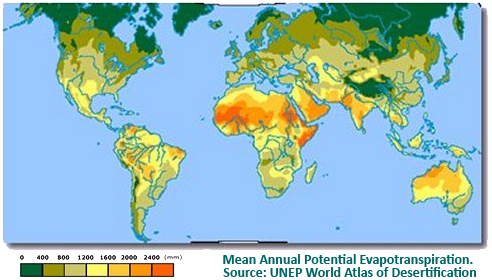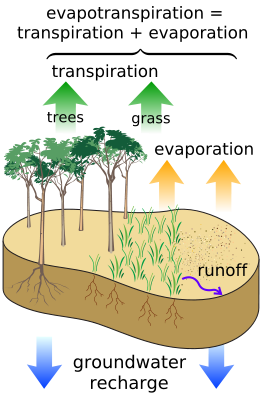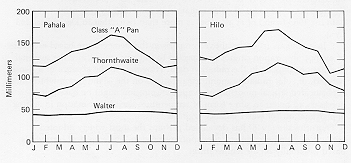Evapotranspiration Explained |
Evapotranspiration (ET) is a term describing the sum of evaporation and plant transpiration from the earth's land surface to atmosphere, including
soil (soil evaporation), and from vegetation (transpiration). The latter two are often the most important contributors to evapotranspiration.
Evaporation accounts for the movement of water to the air from sources such as the soil, canopy interception, and water bodies. Transpiration
accounts for the movement of water within a plant and the subsequent loss of water as vapor through stomata in its leaves. Other contributors to
evapotranspiration may include evaporation from wet canopy surface (wet-canopy evaporation), and evaporation from vegetation-covered water surface
in wetlands.
The process of evapotranspiration is one of the main consumers of solar energy at the Earth's surface. Energy used for evapotranspiration is generally referred to as latent heat flux; however, the term latent heat flux is broad, and includes other related processes unrelated to transpiration including condensation (e.g., fog, dew), and snow and ice sublimation. Apart from precipitation, evapotranspiration is one of the most significant components of the water cycle.
The evaporation component of ET is comprised of the return of water back to the atmosphere through direct evaporative loss from the soil surface, standing water (depression storage), and water on surfaces (intercepted water) such as leaves and/or roofs. Transpired water is that which is used by vegetation and subsequently lost to the atmosphere as vapor. The water generally enters the plant through the root zone, is used for various biophysiological functions including photosynthesis, and then passes back to the atmosphere through the leaf stomates. Transpiration will stop if the vegetation becomes stressed to the wilting point, which is the point in which there is insufficient water left in the soil for a plant to transpire, or if the plant to atmosphere vapor concentration gradient becomes prohibitive to plant physiological processes (e.g. photosynthesis).
Potential evapotranspiration (PET) is a representation of the environmental demand for evapotranspiration and represents the evapotranspiration rate of a short green crop, completely shading the ground, of uniform height and with adequate water status in the soil profile. It is a reflection of the energy available to evaporate water, and of the wind available to transport the water vapor from the ground up into the lower atmosphere. Evapotranspiration is said to equal potential evapotranspiration when there is ample water.
The process of evapotranspiration is one of the main consumers of solar energy at the Earth's surface. Energy used for evapotranspiration is generally referred to as latent heat flux; however, the term latent heat flux is broad, and includes other related processes unrelated to transpiration including condensation (e.g., fog, dew), and snow and ice sublimation. Apart from precipitation, evapotranspiration is one of the most significant components of the water cycle.
The evaporation component of ET is comprised of the return of water back to the atmosphere through direct evaporative loss from the soil surface, standing water (depression storage), and water on surfaces (intercepted water) such as leaves and/or roofs. Transpired water is that which is used by vegetation and subsequently lost to the atmosphere as vapor. The water generally enters the plant through the root zone, is used for various biophysiological functions including photosynthesis, and then passes back to the atmosphere through the leaf stomates. Transpiration will stop if the vegetation becomes stressed to the wilting point, which is the point in which there is insufficient water left in the soil for a plant to transpire, or if the plant to atmosphere vapor concentration gradient becomes prohibitive to plant physiological processes (e.g. photosynthesis).
Potential evapotranspiration (PET) is a representation of the environmental demand for evapotranspiration and represents the evapotranspiration rate of a short green crop, completely shading the ground, of uniform height and with adequate water status in the soil profile. It is a reflection of the energy available to evaporate water, and of the wind available to transport the water vapor from the ground up into the lower atmosphere. Evapotranspiration is said to equal potential evapotranspiration when there is ample water.
| Factors Affecting Evapotranspiration | ||
The rate of evapotranspiration at any location on the Earth's surface is controlled by several factors:
- Energy availability. The more energy available, the greater the rate of evapotranspiration. It takes about 600 calories of heat energy to change 1 gram of liquid water into a gas.
- The humidity gradient away from the surface. The rate and quantity of water vapor entering into the atmosphere both become higher in drier air.
- The wind speed immediately above the surface. The process of evapotranspiration moves water vapor from ground or water surfaces to an adjacent shallow layer that is only a few centimeters thick. When this layer becomes saturated evapotranspiration stops. However, wind can remove this layer replacing it with drier air which increases the potential for evapotranspiration. Winds also affect evapotranspiration by bringing heat energy into an area. A 5-mile-per-hour wind will increase still-air evapotranspiration by 20 percent; a 15-mile-per-hour wind will increase still-air evapotranspiration by 50 percent.
- Water availability. Evapotranspiration cannot occur if water is not available.
- Physical attributes of the vegetation. Such factors as vegetative cover,plant height, leaf area index and leaf shape and the reflectivity of plant surfaces can affect rates of evapotranspiration. For example coniferous forests and alfalfa fields reflect only about 25 percent of solar energy, thus retaining substantial thermal energy to promote transpiration; in contrast, deserts reflect as much as 50 percent of the solar energy, depending on the density of vegetation.
- [Stomatal resistance]. Plants regulate transpiration through adjustment of small openings in the leaves called stomata. As stomata close, the resistance of the leaf to loss of water vapor increases, decreasing to the diffusion of water vapor from plant to the atmosphere.
- Soil characteristics. Soil characteristics that can affect evapotranspiration include its heat capacity, and soil chemistry and albedo.
| Geographical Patterns of Evapotranspiration | ||
 Assuming that moisture is available, evapotranspiration is dependent primarily on the availability of solar energy to vaporize water.
Evapotranspiration therefore varies with latitude, season of year, time of day, and cloud cover. Most of the evapotranspiration of water on the
Earth's surface occurs in the subtropical oceans. In these areas, high quantities of solar radiation provide the energy required to convert liquid
water into a gas. Evapotranspiration generally exceeds precipitation on middle and high latitude landmass areas during the summer season. Once
again, the greater availability of solar radiation during this time enhances the evapotranspiration process.
Assuming that moisture is available, evapotranspiration is dependent primarily on the availability of solar energy to vaporize water.
Evapotranspiration therefore varies with latitude, season of year, time of day, and cloud cover. Most of the evapotranspiration of water on the
Earth's surface occurs in the subtropical oceans. In these areas, high quantities of solar radiation provide the energy required to convert liquid
water into a gas. Evapotranspiration generally exceeds precipitation on middle and high latitude landmass areas during the summer season. Once
again, the greater availability of solar radiation during this time enhances the evapotranspiration process.Estimates of average nationwide evapotranspiration for the contiguous United States range from about 40 percent of the average annual precipitation in the Northwest and Northeast to close to 100 percent in the Southwest. During a drought, the significance of evapotranspiration is magnified, because evapotranspiration continues to deplete the limited remaining water supplies in lakes and streams and the soil.
The lower 5 miles of the atmosphere transports an average of about 40 billion gallons of water vapor over the contiguous United States each day. Slightly more than 10 percent of this moisture, however, is precipitated as rain, sleet, hail, or snow. The greatest proportion, about 67%, is returned to the atmosphere through evapotranspiration. About 29% is discharged from the contiguous United States as surface-water flowing into the Pacific and Atlantic Oceans and across the borders into Canada and Mexico, about 2% is discharged as groundwater outflow, and about 2% is consumed by people, animals, plants, and used for industrial and commercial processes. For most of the United States, evaporation returns less moisture to the atmosphere than does transpiration. Globally, evaporation processes are responsible for an overwhelming majority of the water returned to the atmosphere.
| Evapotranspiration and the Water Cycle | ||
 Evapotranspiration is a significant water loss from a watershed. Types of vegetation and land use significantly affect evapotranspiration, and
therefore the amount of water leaving a watershed. Water that is transpired through leaves comes from the roots. Plants with deep reaching roots
can more consistently transpire water. Herbaceous plants transpire less than woody plants because herbaceous plants usually lack a deep
taproot. Additionally, woody plants keep their structure over long winters while herbaceous plants must grow up from a seed in the spring in seasonal
climates, and will contribute almost nothing to evapotranspiration in the spring. Conifer forests tend to have much higher rates of
evapotranspiration than deciduous forests. This is because their needles offer a superior surface area, resulting in more pores being available for
transpiration by allowing more droplets of rain to be suspended in and around the needles and branches, where some of the droplets can then
be evaporated. Factors that affect evapotranspiration include the plant's growth stage or level of maturity, percentage of soil cover, solar
radiation, humidity, temperature, and wind.
Evapotranspiration is a significant water loss from a watershed. Types of vegetation and land use significantly affect evapotranspiration, and
therefore the amount of water leaving a watershed. Water that is transpired through leaves comes from the roots. Plants with deep reaching roots
can more consistently transpire water. Herbaceous plants transpire less than woody plants because herbaceous plants usually lack a deep
taproot. Additionally, woody plants keep their structure over long winters while herbaceous plants must grow up from a seed in the spring in seasonal
climates, and will contribute almost nothing to evapotranspiration in the spring. Conifer forests tend to have much higher rates of
evapotranspiration than deciduous forests. This is because their needles offer a superior surface area, resulting in more pores being available for
transpiration by allowing more droplets of rain to be suspended in and around the needles and branches, where some of the droplets can then
be evaporated. Factors that affect evapotranspiration include the plant's growth stage or level of maturity, percentage of soil cover, solar
radiation, humidity, temperature, and wind.Through evapotranspiration, forests reduce water yield, except for in unique ecosystems called cloud forests. Trees in cloud forests condense fog or low clouds into liquid water on their surface, which drips down to the ground. These trees still contribute to evapotranspiration, but often condense more water than they evaporate or transpire.
In areas that are not irrigated, actual evapotranspiration is usually no greater than precipitation, with some buffer in time depending on the soil's ability to hold water. It will usually be less because some water will be lost due to percolation or surface runoff. An exception are areas with high water tables, where capillary action can cause water from the groundwater to rise through the soil matrix and to the surface. If potential evapotranspiration is greater than actual precipitation, then soil will dry out, unless artificial irrigation is used.
Evapotranspiration can never be greater than PET, but can be lower if there is not enough water to be evaporated or plants are unable to readily transpire.
| Hydrometeorological Equations | ||
The most general and widely used equation for calculating reference ET is the Penman equation. The Penman-Monteith variation is recommended by
the Food and Agriculture Organization. The simpler Blaney-Criddle equation was popular in the Western United States for many years but it is not
as accurate in regions with higher humidities. Other solutions used includes Makkink, which is simple but must be calibrated to a specific
location, and Hargreaves. To convert the reference evapotranspiration to actual crop evapotranspiration, a crop co-efficient and a stress
co-efficient must be used.
| Potential Evapotranspiration | ||
 Monthly estimated potential evapotranspiration and measured pan evaporation for two locations in Hawaii, Hilo and Pahala. Potential
evapotranspiration (PET) is the amount of water that could be evaporated and transpired if there was sufficient water available. This demand
incorporates the energy available for evaporation and the ability of the lower atmosphere to transport evaporated moisture away from the land
surface. PET is higher in the summer, on less cloudy days, and closer to the equator, because of the higher levels of solar radiation that
provides the energy for evaporation. PET is also higher on windy days because the evaporated moisture can be quickly moved from the ground of
plants, allowing more evaporation to fill its place.
Monthly estimated potential evapotranspiration and measured pan evaporation for two locations in Hawaii, Hilo and Pahala. Potential
evapotranspiration (PET) is the amount of water that could be evaporated and transpired if there was sufficient water available. This demand
incorporates the energy available for evaporation and the ability of the lower atmosphere to transport evaporated moisture away from the land
surface. PET is higher in the summer, on less cloudy days, and closer to the equator, because of the higher levels of solar radiation that
provides the energy for evaporation. PET is also higher on windy days because the evaporated moisture can be quickly moved from the ground of
plants, allowing more evaporation to fill its place.PET is expressed in terms of a depth of water, and can be graphed during the year (see figure). There is usually a pronounced peak in summer, which results from higher temperatures.
Potential evapotranspiration is usually measured indirectly, from other climatic factors, but also depends on the surface type, such free water (for lakes and oceans), the soil type for bare soil, and the vegetation. Often a value for the potential evapotranspiration is calculated at a nearby climate station on a reference surface, conventionally short grass. This value is called the reference evapotranspiration, and can be converted to a potential evapotranspiration by multiplying with a surface coefficient. In agriculture, this is called a crop coefficient. The difference between potential evapotranspiration and precipitation is used in irrigation scheduling.
Average annual PET is often compared to average annual precipitation, P. The ratio of the two, P/PET, is the aridity index.










